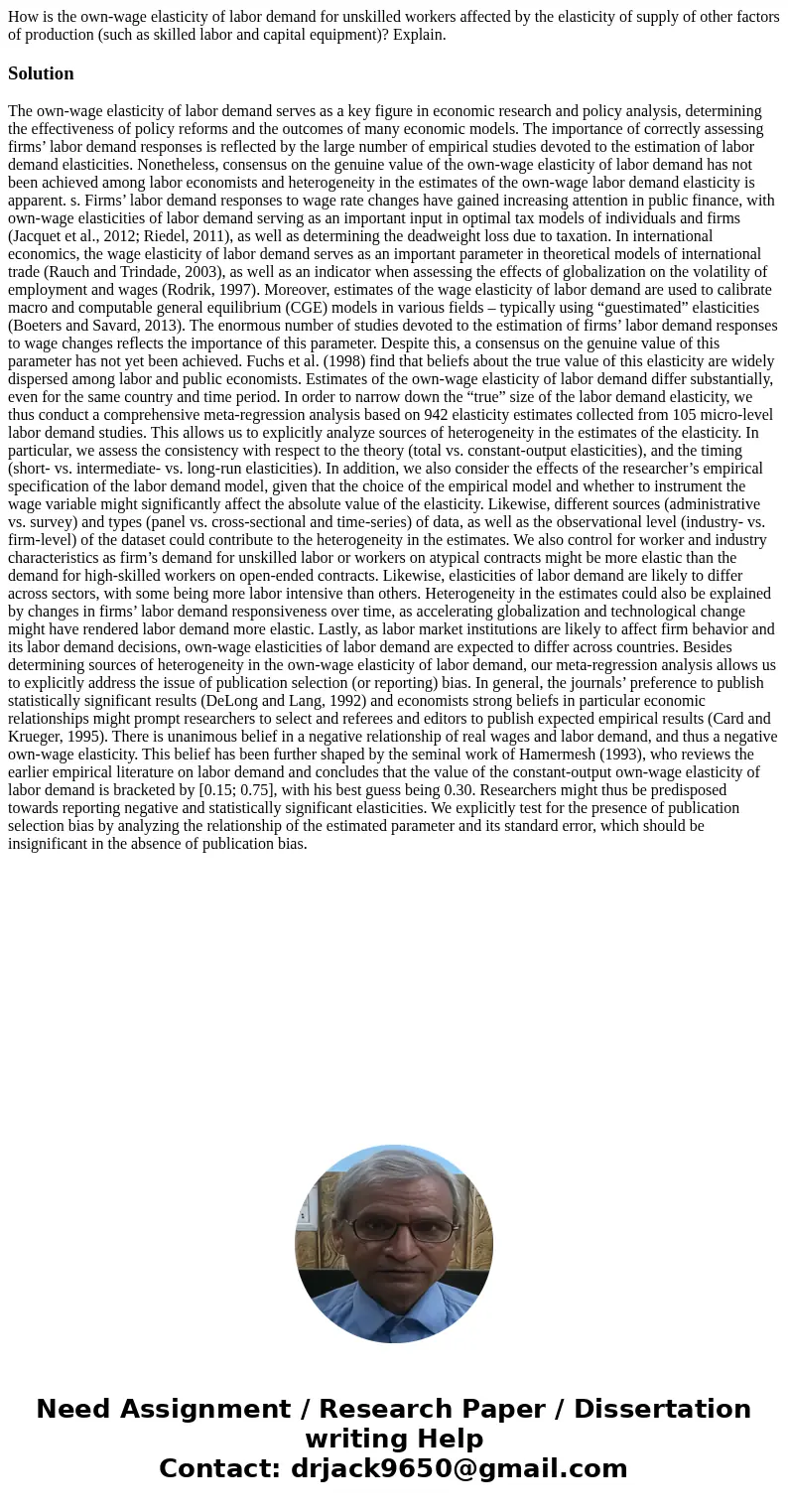How is the ownwage elasticity of labor demand for unskilled
How is the own-wage elasticity of labor demand for unskilled workers affected by the elasticity of supply of other factors of production (such as skilled labor and capital equipment)? Explain.
Solution
The own-wage elasticity of labor demand serves as a key figure in economic research and policy analysis, determining the effectiveness of policy reforms and the outcomes of many economic models. The importance of correctly assessing firms’ labor demand responses is reflected by the large number of empirical studies devoted to the estimation of labor demand elasticities. Nonetheless, consensus on the genuine value of the own-wage elasticity of labor demand has not been achieved among labor economists and heterogeneity in the estimates of the own-wage labor demand elasticity is apparent. s. Firms’ labor demand responses to wage rate changes have gained increasing attention in public finance, with own-wage elasticities of labor demand serving as an important input in optimal tax models of individuals and firms (Jacquet et al., 2012; Riedel, 2011), as well as determining the deadweight loss due to taxation. In international economics, the wage elasticity of labor demand serves as an important parameter in theoretical models of international trade (Rauch and Trindade, 2003), as well as an indicator when assessing the effects of globalization on the volatility of employment and wages (Rodrik, 1997). Moreover, estimates of the wage elasticity of labor demand are used to calibrate macro and computable general equilibrium (CGE) models in various fields – typically using “guestimated” elasticities (Boeters and Savard, 2013). The enormous number of studies devoted to the estimation of firms’ labor demand responses to wage changes reflects the importance of this parameter. Despite this, a consensus on the genuine value of this parameter has not yet been achieved. Fuchs et al. (1998) find that beliefs about the true value of this elasticity are widely dispersed among labor and public economists. Estimates of the own-wage elasticity of labor demand differ substantially, even for the same country and time period. In order to narrow down the “true” size of the labor demand elasticity, we thus conduct a comprehensive meta-regression analysis based on 942 elasticity estimates collected from 105 micro-level labor demand studies. This allows us to explicitly analyze sources of heterogeneity in the estimates of the elasticity. In particular, we assess the consistency with respect to the theory (total vs. constant-output elasticities), and the timing (short- vs. intermediate- vs. long-run elasticities). In addition, we also consider the effects of the researcher’s empirical specification of the labor demand model, given that the choice of the empirical model and whether to instrument the wage variable might significantly affect the absolute value of the elasticity. Likewise, different sources (administrative vs. survey) and types (panel vs. cross-sectional and time-series) of data, as well as the observational level (industry- vs. firm-level) of the dataset could contribute to the heterogeneity in the estimates. We also control for worker and industry characteristics as firm’s demand for unskilled labor or workers on atypical contracts might be more elastic than the demand for high-skilled workers on open-ended contracts. Likewise, elasticities of labor demand are likely to differ across sectors, with some being more labor intensive than others. Heterogeneity in the estimates could also be explained by changes in firms’ labor demand responsiveness over time, as accelerating globalization and technological change might have rendered labor demand more elastic. Lastly, as labor market institutions are likely to affect firm behavior and its labor demand decisions, own-wage elasticities of labor demand are expected to differ across countries. Besides determining sources of heterogeneity in the own-wage elasticity of labor demand, our meta-regression analysis allows us to explicitly address the issue of publication selection (or reporting) bias. In general, the journals’ preference to publish statistically significant results (DeLong and Lang, 1992) and economists strong beliefs in particular economic relationships might prompt researchers to select and referees and editors to publish expected empirical results (Card and Krueger, 1995). There is unanimous belief in a negative relationship of real wages and labor demand, and thus a negative own-wage elasticity. This belief has been further shaped by the seminal work of Hamermesh (1993), who reviews the earlier empirical literature on labor demand and concludes that the value of the constant-output own-wage elasticity of labor demand is bracketed by [0.15; 0.75], with his best guess being 0.30. Researchers might thus be predisposed towards reporting negative and statistically significant elasticities. We explicitly test for the presence of publication selection bias by analyzing the relationship of the estimated parameter and its standard error, which should be insignificant in the absence of publication bias.

 Homework Sourse
Homework Sourse